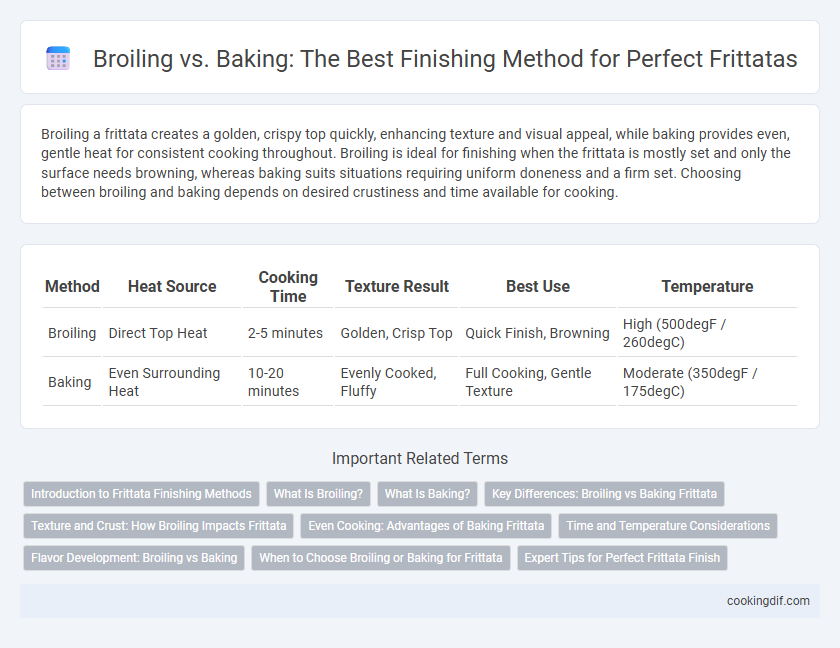Broiling a frittata creates a golden, crispy top quickly, enhancing texture and visual appeal, while baking provides even, gentle heat for consistent cooking throughout. Broiling is ideal for finishing when the frittata is mostly set and only the surface needs browning, whereas baking suits situations requiring uniform doneness and a firm set. Choosing between broiling and baking depends on desired crustiness and time available for cooking.
Table of Comparison
| Method | Heat Source | Cooking Time | Texture Result | Best Use | Temperature |
|---|---|---|---|---|---|
| Broiling | Direct Top Heat | 2-5 minutes | Golden, Crisp Top | Quick Finish, Browning | High (500degF / 260degC) |
| Baking | Even Surrounding Heat | 10-20 minutes | Evenly Cooked, Fluffy | Full Cooking, Gentle Texture | Moderate (350degF / 175degC) |
Introduction to Frittata Finishing Methods
Broiling and baking are two popular finishing methods for frittatas that significantly impact texture and flavor. Baking ensures even cooking with a tender, fully set interior, while broiling creates a golden, crispy top layer with a slightly caramelized finish. Choosing the right method depends on desired browning and cooking speed preferences for the perfect frittata finish.
What Is Broiling?
Broiling is a high-heat cooking method where heat is applied directly from above, creating a quick, intense browning effect on the frittata's surface. Unlike baking, which uses surrounding hot air to cook evenly throughout, broiling is ideal for finishing a frittata by quickly melting cheese and crisping the top without overcooking the interior. This technique enhances texture and presentation, making broiling a popular choice for achieving a golden, bubbly frittata finish.
What Is Baking?
Baking a frittata involves cooking it evenly in an oven at a consistent temperature, typically around 350degF (175degC), which allows the eggs to set gently without browning too quickly. This method ensures a tender, fluffy texture and prevents the top from drying out or overcooking. Compared to broiling, baking provides a controlled environment perfect for thorough cooking and retaining moisture throughout the dish.
Key Differences: Broiling vs Baking Frittata
Broiling a frittata uses intense, direct heat from above, creating a golden, crispy top in a short time, ideal for quickly finishing and browning. Baking applies even, indirect heat surrounding the frittata, ensuring thorough cooking and a firm, uniformly set texture without rapid browning. Choosing broiling emphasizes texture contrast and speed, while baking prioritizes consistent doneness and structure.
Texture and Crust: How Broiling Impacts Frittata
Broiling a frittata creates a golden, crisp crust by exposing the top to high, direct heat, which intensifies browning and caramelization. Compared to baking, broiling results in a slightly firmer texture on the surface while keeping the interior tender and creamy. This method enhances the overall contrast between the crunchy top layer and the soft egg base, elevating the frittata's sensory experience.
Even Cooking: Advantages of Baking Frittata
Baking a frittata ensures even cooking by surrounding it with consistent, gentle heat that cooks the eggs uniformly from all angles. This method reduces the risk of overcooked edges or undercooked centers often seen with broiling, which applies intense top heat. Baking also allows the frittata to set slowly, resulting in a tender, creamy texture throughout.
Time and Temperature Considerations
Broiling a frittata typically requires 2 to 4 minutes under high heat at around 500degF, which quickly sets the top without overcooking the interior. Baking a frittata usually involves cooking at a moderate temperature of 350degF to 375degF for 15 to 25 minutes, ensuring even cooking and a tender texture throughout. Choosing broiling favors speed and a browned finish, while baking provides gradual heat for consistent doneness.
Flavor Development: Broiling vs Baking
Broiling a frittata intensifies flavor by promoting caramelization and browning on the surface, creating a rich, slightly smoky taste. Baking provides a more even heat distribution, resulting in a tender texture with milder, balanced flavors. The choice between broiling and baking directly impacts the depth and complexity of the frittata's flavor profile.
When to Choose Broiling or Baking for Frittata
Broiling a frittata is ideal for achieving a golden, crispy top quickly, especially when the eggs are already mostly set and you want to finish with a caramelized surface. Baking is preferred for cooking the frittata evenly from edge to center, making it suitable for thicker mixtures with various fillings that require gentle, thorough cooking. Choose broiling for a rapid finish and a textured crust, and baking for consistent heat distribution and a tender, fully cooked interior.
Expert Tips for Perfect Frittata Finish
Broiling a frittata quickly crisps the top and adds a golden brown finish, ideal for a slightly caramelized texture, while baking ensures even cooking and a tender, custardy interior. Expert chefs recommend starting the frittata on the stovetop and finishing under the broiler for about 2-3 minutes to achieve a perfectly set, bubbly surface without overcooking the eggs. Using an oven-safe skillet and monitoring closely prevents burning and creates a balanced, flavorful frittata with a professional finish.
Broiling vs baking for frittata finishing methods Infographic

 cookingdif.com
cookingdif.com